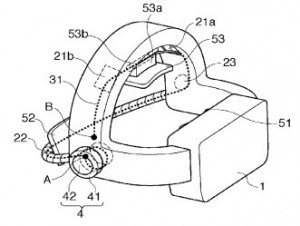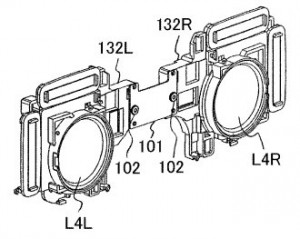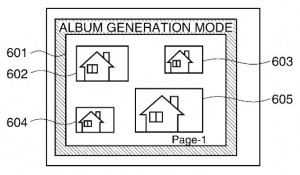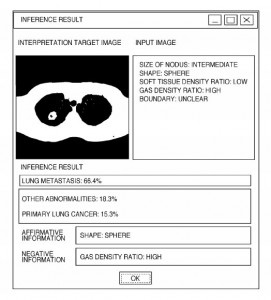Headquartered in Tokyo, Japan, Canon Inc. is a major developer of optical and imaging products, including copiers, printers, cameras and medical equipment, and a massive player in fields of intellectual properties. In early January, the company announced a $100 million commitment to expanding operations in printer cartridge and toner manufacturing at a facility in Newport News. VA. Canon is still the global leader in digital single-lens reflex (DSLR) cameras and lenses, although it’s been facing some tough recent competition in that field from the likes of Fuji, Samsung, Sony and Olympus. Canon has been increasing its offerings in photography services like its new hdAlbum service for creating customizable photo albums, a concept we’ll explore a little more deeply in today’s column.
Our perusal of Canon’s patents issued by the U.S. Patent and Trademark Office shows that there are a myriad of other technologies being developed by this corporation than digital cameras. A couple of patents are related to improvements to head-mounted displays, including one method of creating mixed reality images for a user based on his or her surrounding environment. More comfortable ophthalmic devices and binocular lenses are also featured in a couple of patents that we delve into today.
The patent applications of Canon that caught our interest today showcase a singular focus on digital cameras, including a service of generating a customizable photo album similar to the hdAlbum service described above. Another couple of patent applications pertain to medical technologies, including a support apparatus that can provide diagnostic analysis that incorporates a variety of medical imaging procedures.
[Companies-1]
Canon’s Issued Patents: Head-Mounted Displays, Stabilized Lens Binoculars and Self-Cleaning Printers
For a number of years now, Canon has held a very powerful position in terms of its portfolio of U.S. patent grants. In 2014, Canon was issued 4,055 U.S. patents from the USPTO, the third-highest total of all global entities seeking U.S. patents and the highest total of any Japanese company. Canon held the same standing in 2013, during which year it received 3,825 patents from the USPTO. For the past decade, in fact, Canon has been the top earner of U.S. patent grants of any company from Japan.
We have been seeing a number of augmented reality technologies being developed by various Companies We Follow, and Canon is no different. We found a patent issued to protect a device providing a 3D image display interface to  users which is disclosed by U.S. Patent No. 8928557, issued under the title Head-Mounted Device. The head-mounted device claimed here includes a pressing member that presses the head of a user, a string member that links the pressing member with an adjusting unit which adjusts the length of a string member, a framed display that shows images to a user and a guide member for the string member and pressing member. The configuration of this head-mounted device reduces user discomfort experienced when excess force is applied through the pressing member by enabling the adjustment of a plurality of pressing members. We also took note of the mixed reality imaging techniques that are protected by U.S. Patent No. 8933965, entitled Method for Calculating Light Source Information and Generating Images Combining Real and Virtual Images. The patent claims a method of presenting a combined image on a head-mounted display device by receiving image data for a plurality of captured images relating to different parts of a real space, obtaining position and orientation data of the imaging apparatus, performing a generating step for modeling image data based on received image data and position and orientation data, performing a step of estimating a light source, performing a second generating step for generating a virtual image based on light source information and a virtual object and performing a combining step for combining the real space and virtual images. This real-time system for light source information detection enables the mixed reality system to incorporate changes in lighting conditions into the mixed reality images that are created.
users which is disclosed by U.S. Patent No. 8928557, issued under the title Head-Mounted Device. The head-mounted device claimed here includes a pressing member that presses the head of a user, a string member that links the pressing member with an adjusting unit which adjusts the length of a string member, a framed display that shows images to a user and a guide member for the string member and pressing member. The configuration of this head-mounted device reduces user discomfort experienced when excess force is applied through the pressing member by enabling the adjustment of a plurality of pressing members. We also took note of the mixed reality imaging techniques that are protected by U.S. Patent No. 8933965, entitled Method for Calculating Light Source Information and Generating Images Combining Real and Virtual Images. The patent claims a method of presenting a combined image on a head-mounted display device by receiving image data for a plurality of captured images relating to different parts of a real space, obtaining position and orientation data of the imaging apparatus, performing a generating step for modeling image data based on received image data and position and orientation data, performing a step of estimating a light source, performing a second generating step for generating a virtual image based on light source information and a virtual object and performing a combining step for combining the real space and virtual images. This real-time system for light source information detection enables the mixed reality system to incorporate changes in lighting conditions into the mixed reality images that are created.
Canon’s medical device innovations also stem into the world of vision care, as can be seen in the recently issued U.S. Patent No. 8931901, issued under the title Ophthalmologic Apparatus. The ophthalmologic apparatus claimed here includes a projection optical system that projects a light flux on a fundus of a subject’s eye, a beam splitting member that splits an optical path corresponding to the light flux and an image-forming optical system that receives a light flux from the fundus. The technology also involves the use of an optical element that reduces astigmatism generated by certain beam splitting members, like dichroic mirrors, used by ophthalmologic apparatuses.
 We were intrigued to note a novel imaging device that has been invented by Canon which we were able to explore within U.S. Patent No. 8922891, which is titled Binoculars Having Image Stabilizing Function. The binoculars protected by this patent include both a left and a right optical system, each utilizing a respective left image or right image lens, a lens holder configured to hold those stabilizing lenses and a coupling unit which secures the left and right lens holding members to each other. This configuration improves on prior binoculars designed to incorporate stabilizing lenses which could sometimes cause discomfort to wearers when held at a certain incline relative to an optical axis in such a way that caused a change in the focus of the lens.
We were intrigued to note a novel imaging device that has been invented by Canon which we were able to explore within U.S. Patent No. 8922891, which is titled Binoculars Having Image Stabilizing Function. The binoculars protected by this patent include both a left and a right optical system, each utilizing a respective left image or right image lens, a lens holder configured to hold those stabilizing lenses and a coupling unit which secures the left and right lens holding members to each other. This configuration improves on prior binoculars designed to incorporate stabilizing lenses which could sometimes cause discomfort to wearers when held at a certain incline relative to an optical axis in such a way that caused a change in the focus of the lens.
We also picked up on a couple of patents that extend Canon’s holdings in the area of printing technologies, both for printer units and inks. A self-cleaning style of printer is at the center of the recently issued U.S. Patent No. 8909113, titled Printing Apparatus that Cleans Fixing Device, Method of Controlling the Printing Apparatus, and Storage Medium. The printing apparatus that includes a device for fixing an image on a sheet claimed here includes a unit that performs multiple cleaning processes to clean the fixing device by using a sheet upon which an image is formed having different numbers of color of recording material. The apparatus also includes a determination unit that initiates performance of the cleaning process based on a number of sheets printed. This innovation is an improved system for cleaning toner from a pressure roller within a printing apparatus. An improved toner mixture for providing magenta color with better color quality characteristics is described within U.S. Patent No. 8906587, which is titled Colored Resin Powder and Toner Using the Colored Resin Powder. The colored resin powder claimed here includes a water-insoluble coloring matter compound composed of a general formula included in the patent as well as a binder resin. The magenta toner of this invention achieves improved color saturation, tone and electrophotographic characteristics, remaining faithful to an original image while providing enhanced transparency.
[Companies-4]
Patent Applications of Note: Many Digital Imaging Technologies and Medical Innovations
The research and development aims of Canon are global in scope and the corporation has worked to achieve a regional headquarter infrastructure that includes multiple innovation centers in Japan, Europe and the United States. Canon’s various subsidiaries are often focused on inventing products or systems outside of its typical offering of imaging products. For example, Canon U.S. Life Sciences is an American subsidiary which develops technologies in molecular diagnostics for medical fields. In November of last year, Canon opened one of its latest innovation centers in Canada at the Communitech Hub in Kitchener, Ontario, which will focus on mobile communication and imaging tech.
A couple of the technologies we noted in Canon’s recently filed patent applications are directed at improvements to the company’s large line of digital cameras. A newly developed digital camera unit that can easily format a number of stored images into a useful collection is discussed within U.S. Patent Application No. 20140375839, titled  Image Pickup Apparatus Capable of Easily Generating Album, Method of Controlling the Same, and Storage Medium. The image pickup apparatus that would be protected includes a display control unit that directs a display to show multiple frames as well as still images or live view images obtained by the apparatus, a detection unit for detecting a touch operation within one of the frames and an image pickup processing unit for generating a still image from a live view image within a frame in response to a touch operation. This system makes it easier for a camera operator to layout captured images in a desired chronology without having to capture the images in a specific sequence. Technologies for improving data transmission from image capture devices are at the center of U.S. Patent Application No. 20150002352, entitled Manufacturing Method of a Dielectric Material and Its Applications to Millimeter-Waves Beam Forming Antenna Systems. This invention is intended to produce an antenna for imaging devices that supports the large data transmission rates needed to transmit images to a high-definition display device at multiple gigabytes per second through wireless communications. The patent application claims a method of manufacturing a dielectric material body with a predefined variation in dielectric permittivity in at least one direction by shaping at least one part of a dielectric material body in one direction and at least partially forming the shaped dielectric material body. We also took note of an interesting technology that allows multiple people to interact simultaneously with content stored on a single device, explained within U.S. Patent Application No. 20150009415, which is titled Projected User Interface System for Multiple Users. The method of projecting a user interface with a calculated orientation claimed here involves detecting gestures of a plurality of users associated with a user interface projecting, applying a weighting to the detected gestures that represents a level of interaction between the user and an interface, calculating an orientation of the user interface based on the gesture data and projecting the user interface at that orientation. This innovation would allow a user interface system coupled to a camera to react to body gestures, such as a person leaning forward, to generate a projected view of the user interface for multiple viewers.
Image Pickup Apparatus Capable of Easily Generating Album, Method of Controlling the Same, and Storage Medium. The image pickup apparatus that would be protected includes a display control unit that directs a display to show multiple frames as well as still images or live view images obtained by the apparatus, a detection unit for detecting a touch operation within one of the frames and an image pickup processing unit for generating a still image from a live view image within a frame in response to a touch operation. This system makes it easier for a camera operator to layout captured images in a desired chronology without having to capture the images in a specific sequence. Technologies for improving data transmission from image capture devices are at the center of U.S. Patent Application No. 20150002352, entitled Manufacturing Method of a Dielectric Material and Its Applications to Millimeter-Waves Beam Forming Antenna Systems. This invention is intended to produce an antenna for imaging devices that supports the large data transmission rates needed to transmit images to a high-definition display device at multiple gigabytes per second through wireless communications. The patent application claims a method of manufacturing a dielectric material body with a predefined variation in dielectric permittivity in at least one direction by shaping at least one part of a dielectric material body in one direction and at least partially forming the shaped dielectric material body. We also took note of an interesting technology that allows multiple people to interact simultaneously with content stored on a single device, explained within U.S. Patent Application No. 20150009415, which is titled Projected User Interface System for Multiple Users. The method of projecting a user interface with a calculated orientation claimed here involves detecting gestures of a plurality of users associated with a user interface projecting, applying a weighting to the detected gestures that represents a level of interaction between the user and an interface, calculating an orientation of the user interface based on the gesture data and projecting the user interface at that orientation. This innovation would allow a user interface system coupled to a camera to react to body gestures, such as a person leaning forward, to generate a projected view of the user interface for multiple viewers.
 As we mentioned above, some of Canon’s R&D activities also extend into the field of medical technologies. Tools for reducing the load on a physician for analyzing medical data to perform a diagnosis is addressed by the innovation within U.S. Patent Application No. 20150012474, which is titled Medical Decision Making Support Apparatus and Control Method for the Same. The sole claim of this patent application would protect a medical decision making support apparatus that includes an inference means that performs inference processing associated with a medical diagnosis based on medical information inputs, a calculation means for calculating a degree of denial or affirmation of the inference results and a presentation means for presenting an inference result as well as medical information. This system is capable of providing diagnostic analysis related to a variety of medical imaging systems, including ultrasound, computerized tomography (CT) and magnetic resonance imaging (MRI). Materials that are more similar to human tissues for the training of human operators using certain medical diagnostic tools are explained by U.S. Patent Application No. 20140378573, issued under the title Photoacoustic Matching Material and Human Tissue Simulation Material. The patent application claims a phantom for a photoacoustic wave diagnostic apparatus that is comprised of a base material and an object to be detected, both of which are made up of an inorganic oxide and a pigment which are dispersed within a polyol; the dispersed percentage of the pigment differs in the base material from the objected to be detected. This phantom, or human tissue simulation material, has acoustic and optical properties that more similarly match those characteristics of human tissues, useful for accurate training of engineers on photoacoustic wave diagnostic apparatuses.
As we mentioned above, some of Canon’s R&D activities also extend into the field of medical technologies. Tools for reducing the load on a physician for analyzing medical data to perform a diagnosis is addressed by the innovation within U.S. Patent Application No. 20150012474, which is titled Medical Decision Making Support Apparatus and Control Method for the Same. The sole claim of this patent application would protect a medical decision making support apparatus that includes an inference means that performs inference processing associated with a medical diagnosis based on medical information inputs, a calculation means for calculating a degree of denial or affirmation of the inference results and a presentation means for presenting an inference result as well as medical information. This system is capable of providing diagnostic analysis related to a variety of medical imaging systems, including ultrasound, computerized tomography (CT) and magnetic resonance imaging (MRI). Materials that are more similar to human tissues for the training of human operators using certain medical diagnostic tools are explained by U.S. Patent Application No. 20140378573, issued under the title Photoacoustic Matching Material and Human Tissue Simulation Material. The patent application claims a phantom for a photoacoustic wave diagnostic apparatus that is comprised of a base material and an object to be detected, both of which are made up of an inorganic oxide and a pigment which are dispersed within a polyol; the dispersed percentage of the pigment differs in the base material from the objected to be detected. This phantom, or human tissue simulation material, has acoustic and optical properties that more similarly match those characteristics of human tissues, useful for accurate training of engineers on photoacoustic wave diagnostic apparatuses.
An improved printing unit for the reproduction of copy forgery-inhibited patterns, which can discourage and prevent unauthorized copies of sensitive content, has been outlined by U.S. Patent Application No. 20150003845, titled Image Forming Apparatus that Informs Inspection of Printed Matter, Method of Controlling the Same, and Storage Medium. The innovation is intended to address shortcomings in inspecting sheets which have been printed with a copy forgery-inhibited pattern to determine printing defects. The patent application claims an image forming apparatus that includes a printing unit, a reading unit that reads a printed sheet to acquire inspection product image data, a generation unit that generates reference image data formed by excluding image portions that cannot be read by the reading unit and a determination unit which determines that the printed sheet is free from defective printing.
The visual analysis of images based on a variety of features is another area of research and development focus for Canon, as is evidenced by U.S. Patent Application No. 20140372439, which is titled Systems and Methods for Creating a Visual Vocabulary. The patent application claims a method for creating a visual vocabulary by extracting a plurality of descriptors from images, clustering descriptors into augmented-space clusters that include visual similarities and label similarities, generating descriptor-space clusters based on the augmented-space clusters and generating classifiers for the augmented-space clusters associated with the descriptor-space clusters. This invention is directed at the automated building of a visual vocabulary capable of enabling image analysis based on various features, like shape or color.

![[IPWatchdog Logo]](https://ipwatchdog.com/wp-content/themes/IPWatchdog%20-%202023/assets/images/temp/logo-small@2x.png)

![[Advertisement]](https://ipwatchdog.com/wp-content/uploads/2024/04/UnitedLex-May-2-2024-sidebar-700x500-1.jpg)
![[Advertisement]](https://ipwatchdog.com/wp-content/uploads/2024/04/Artificial-Intelligence-2024-REPLAY-sidebar-700x500-corrected.jpg)
![[Advertisement]](https://ipwatchdog.com/wp-content/uploads/2024/04/Patent-Litigation-Masters-2024-sidebar-700x500-1.jpg)

![[Advertisement]](https://ipwatchdog.com/wp-content/uploads/2021/12/WEBINAR-336-x-280-px.png)
![[Advertisement]](https://ipwatchdog.com/wp-content/uploads/2021/12/2021-Patent-Practice-on-Demand-recorded-Feb-2021-336-x-280.jpg)
![[Advertisement]](https://ipwatchdog.com/wp-content/uploads/2021/12/Ad-4-The-Invent-Patent-System™.png)






Join the Discussion
2 comments so far.